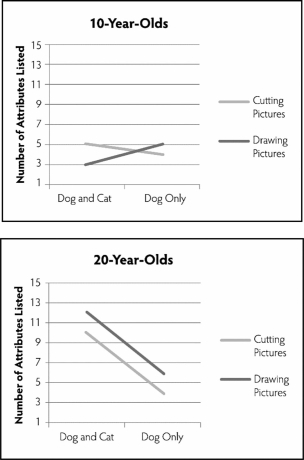(The first paragraph is repeated from earlier.The second paragraph is specific to the new set of questions.The first paragraph is necessary to set up the original study. )
Dr.Elder was interested in the way people recognize objects as members of categories.For example,what makes us recognize a dog as being a dog and not a cat? More specifically,he was curious as to whether people think about categories in a more complex way if they contemplate an "opposite" category first.For example,does a person think more differently about the category of "southern" if they are also thinking about the category of "northern"? He is also curious as to whether people categorize differently if they are exposed to category members compared with generating category members.Dr.Elder has four groups of participants (with 30 people in each group) .In Group A,participants were told to cut out pictures of dogs and cats from magazines.In Group B,participants were told to cut out pictures of just dogs from magazines.In Group C,participants were told to draw pictures of cats and dogs.In Group D,participants were told to draw pictures of just dogs.After doing this for 30 minutes,participants in all groups were asked to list the attributes that define the "dog" category.Having a higher number of attributes listed was considered to be an indication of thinking about the category in a more complex way.
Dr.Elder also is curious as to whether categorization happens similarly for children as it does for adults.As such,he recruits a group of 10-year-olds and a group of 20-year-olds to participate in the study.The results are below.

-In the study described above,Dr.Elder will need to examine how many two-way interactions?
Definitions:
Meta-Analysis
A statistical technique for combining the findings from independent studies to identify trends or common effects.
Experiments
Scientific procedures undertaken to make a discovery, test a hypothesis, or demonstrate a known fact.
Weighting
The process of assigning different levels of importance or coefficients to various elements in a calculation or assessment.
Self-Help Groups
Peer-led organizations where members share their experiences and support each other in solving common problems.
Q1: Dr. Ellison finds a relation between amount
Q10: Jenny reads the following headline on an
Q14: A correlation-based statistic called _ is commonly
Q17: What is the difference between a posttest-only
Q23: Experiments use random assignment to avoid which
Q28: Dr.Gavin is conducting a 2×4 independent-groups factorial
Q29: Imagine that Dr.Ewell calculates an ICC for
Q34: Dr.Kang sends his study to a journal
Q34: Benjamin is a social psychologist who studies
Q39: Dr.Kline plans to use deception in his